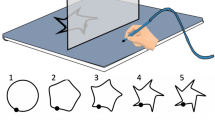Abstract
In two experiments using a center-out task, we investigated kinesthetic-motor and auditory-motor integrations in 5- to 12-year-old children and young adults. In experiment 1, participants moved a pen on a digitizing tablet from a starting position to one of three targets (visuo-motor condition), and then to one of four targets without visual feedback of the movement. In both conditions, we found that with increasing age, the children moved faster and straighter, and became less variable in their feedforward control. Higher control demands for movements toward the contralateral side were reflected in longer movement times and decreased spatial accuracy across all age groups. When feedforward control relies predominantly on kinesthesia, 7- to 10-year-old children were more variable, indicating difficulties in switching between feedforward and feedback control efficiently during that age. An inverse age progression was found for directional endpoint error; larger errors increasing with age likely reflect stronger functional lateralization for the dominant hand. In experiment 2, the same visuo-motor condition was followed by an auditory-motor condition in which participants had to move to acoustic targets (either white band or one-third octave noise). Since in the latter directional cues come exclusively from transcallosally mediated interaural time differences, we hypothesized that auditory-motor representations would show age effects. The results did not show a clear age effect, suggesting that corpus callosum functionality is sufficient in children to allow them to form accurate auditory-motor maps already at a young age.





Similar content being viewed by others
References
Abel SM, Giguère C, Consoli A, Papsin BC (2000) The effect of aging on horizontal plane sound localization. J Acoust Soc Am 108:743–752
Bard C, Hay L, Fleury M (1990) Timing and accuracy of visually directed movements in children: control of direction and amplitude components. J Exp Child Psychol 50:102–118
Boulinguez P, Nougier V, Velay JL (2001) Manual asymmetries in reaching movement control. I: study of right-handers. Cortex 37:101–122
Boyer EO, Babayan BM, Bevilacqua F, Noisternig M, Warusfel O, Roby-Brami A, Hanneton S, Viaud-Delmon I (2013) From ear to hand: the role of the auditory-motor loop in pointing to an auditory source. Front Comput Neurosci 7:26. doi:10.3389/fncom.2013.00026
Bradshaw JL, Spataro JA, Harris M, Nettleton NC, Bradshaw J (1988) Crossing the midline by four to eight year old children. Neuropsychologia 26:221–235
Contreras-Vidal JL (2006) Development of forward models for hand localization and movement control in 6- to 10-year-old children. Hum Mov Sci 25:634–645. doi:10.1016/j.humov.2006.07.006
Contreras-Vidal JL, Bo J, Boudreau JP, Clark JE (2005) Development of visuomotor representations for hand movement in young children. Exp Brain Res 162:155–164. doi:10.1007/s00221-004-2123-7
Desmurget M, Rossetti Y, Prablanc C, Stelmach GE, Jeannerod M (1995) Representation of hand position prior to movement and motor variability. Can J Physiol Pharmacol 73:262–272
Di Stefano M, Morelli M, Marzi CA, Berlucchi G (1980) Hemispheric control of unilateral and bilateral movements of proximal and distal parts of the arm as inferred from simple reaction time to lateralized light stimuli in man. Exp Brain Res 38:197–204
Dounskaia NV, Ketcham CJ, Stelmach GE (2002) Influence of biomechanical constraints on horizontal arm movements. Mot Control 6:366–387
Elliott D, Carson RG, Goodman D, Chua R (1991) Discrete vs. continuous visual control of manual aiming. Hum Mov Sci 10:393–418
Hay L (1979) Spatial-temporal analysis of movements in children. J Mot Behav 11:189–200. doi:10.1080/00222895.1979.10735187
Hay L, Fleury M, Bard C, Teasdale N (1994) Resolving power of the perceptual- and sensorimotor systems in 6- to 10-year-old children. J Mot Behav 26:36–42. doi:10.1080/00222895.1994.9941659
Henderson S, Sugden D (1992) The movement assessment battery for children. Psychological Cooperation, London
Ishihara M, Imanaka K, Mori S (2002) Lateralized effects of target location on reaction times when preparing for manual aiming at a visual target. Hum Mov Sci 21:563–582
Jansen-Osmann P, Richter S, Konczak J, Kalveram K-T (2002) Force adaptation transfers to untrained workspace regions in children: evidence for developing inverse dynamic motor models. Exp Brain Res 143:212–220. doi:10.1007/s00221-001-0982-8
Jeannerod M (1986) Mechanisms of visuomotor coordination: a study in normal and brain-damaged subjects. Neuropsychologia 24:41–78
Kagerer FA, Clark JE (2014a) Development of interactions between sensorimotor representations in school-aged children. Hum Mov Sci 34:164–177. doi:10.1016/j.humov.2014.02.001
Kagerer FA, Clark JE (2014b) Development of interactions between sensorimotor representations in school-aged children. Hum Mov Sci. doi:10.1016/j.humov.2014.02.001
King BR, Kagerer FA, Contreras-Vidal JL, Clark JE (2009) Evidence for multisensory spatial-to-motor transformations in aiming movements of children. J Neurophysiol 101:315–322. doi:10.1152/jn.90781.2008
King BR, Kagerer FA, Harring JR, Contreras-Vidal JL, Clark JE (2011) Multisensory adaptation of spatial-to-motor transformations in children with developmental coordination disorder. Exp Brain Res 212:257–265. doi:10.1007/s00221-011-2722-z
Muetzel RL, Collins PF, Mueller BA, Schissel AM, Lim KO, Luciana M (2008) The development of corpus callosum microstructure and associations with bimanual task performance in healthy adolescents. NeuroImage 39:1918–1925. doi:10.1016/j.neuroimage.2007.10.018
Mutha PK, Haaland KY, Sainburg RL (2013) Rethinking motor lateralization: specialized but complementary mechanisms for motor control of each arm. PLoS ONE 8:e58582. doi:10.1371/journal.pone.0058582
Olivier I, Hay L, Bard C, Fleury M (2007) Age-related differences in the reaching and grasping coordination in children: unimanual and bimanual tasks. Exp Brain Res 179:17–27. doi:10.1007/s00221-006-0762-6
Poirier P, Miljours S, Lassonde M, Lepore F (1993) Sound localization in acallosal human listeners. Brain 116(Pt 1):53–69
Poirier P, Lepore F, Provençal C, Ptito M, Guillemot JP (1995) Binaural noise stimulation of auditory callosal fibers of the cat: responses to interaural time delays. Exp Brain Res 104:30–40
Pouget A, Ducom JC, Torri J, Bavelier D (2002) Multisensory spatial representations in eye-centered coordinates for reaching. Cognition 83:B1–B11
Proteau L, Isabelle G (2002) On the role of visual afferent information for the control of aiming movements toward targets of different sizes. J Mot Behav 34:367–384. doi:10.1080/00222890209601954
Provine RR, Westerman JA (1979) Crossing the midline: limits of early eye-hand behavior. Child Dev 50:437–441
Rossetti Y, Tadary B, Prablanc C (1994) Optimal contributions of head and eye positions to spatial accuracy in man tested by visually directed pointing. Exp Brain Res 97:487–496
Sainburg RL (2002) Evidence for a dynamic-dominance hypothesis of handedness. Exp Brain Res 142:241–258. doi:10.1007/s00221-001-0913-8
Shadmehr R, Krakauer JW (2008) A computational neuroanatomy for motor control. Exp Brain Res 185:359–381. doi:10.1007/s00221-008-1280-5
Smits-Engelsman BCM, Westenberg Y, Duysens J (2008) Children with developmental coordination disorder are equally able to generate force but show more variability than typically developing children. Hum Mov Sci 27:296–309. doi:10.1016/j.humov.2008.02.005
Tahej P-K, Ferrel-Chapus C, Olivier I, Ginhac D, Rolland J-P (2012) Multiple representations and mechanisms for visuomotor adaptation in young children. Hum Mov Sci 31:1425–1435. doi:10.1016/j.humov.2012.02.016
Teasdale N, Bard C, Fleury M, Young DE, Proteau L (1993) Determining movement onsets from temporal series. J Mot Behav 25:97–106. doi:10.1080/00222895.1993.9941644
van Beers RJ, Sittig AC, Denier van der Gon JJ (1998) The precision of proprioceptive position sense. Exp Brain Res 122:367–377
van Hof R, van der Kamp J, Savelsbergh GJR (2002) The relation of unimanual and bimanual reaching to crossing the midline. Child Dev 73:1353–1362
von Hofsten C, Rösblad B (1988) The integration of sensory information in the development of precise manual pointing. Neuropsychologia 26:805–821
Wann JP, Ibrahim SF (1992) Does limb proprioception drift? Exp Brain Res 91:162–166
Wightman FL, Kistler DJ (1992) The dominant role of low-frequency interaural time differences in sound localization. J Acoust Soc Am 91:1648–1661
Wolpert DM, Kawato M (1998) Multiple paired forward and inverse models for motor control. Neural Netw 11:1317–1329
Yadav V, Sainburg RL (2011) Motor lateralization is characterized by a serial hybrid control scheme. Neuroscience 196:153–167. doi:10.1016/j.neuroscience.2011.08.039
Yan JH, Thomas JR, Stelmach GE, Thomas KT (2000) Developmental features of rapid aiming arm movements across the lifespan. J Mot Behav 32:121–140. doi:10.1080/00222890009601365
Acknowledgments
This research was supported by National Institute of Child Health and Human Development Grants R03-HD-050372 to FAK, and R01-HD-42527 to JEC.
Author information
Authors and Affiliations
Corresponding author
Rights and permissions
About this article
Cite this article
Kagerer, F.A., Clark, J.E. Development of kinesthetic-motor and auditory-motor representations in school-aged children. Exp Brain Res 233, 2181–2194 (2015). https://doi.org/10.1007/s00221-015-4288-7
Received:
Accepted:
Published:
Issue Date:
DOI: https://doi.org/10.1007/s00221-015-4288-7




